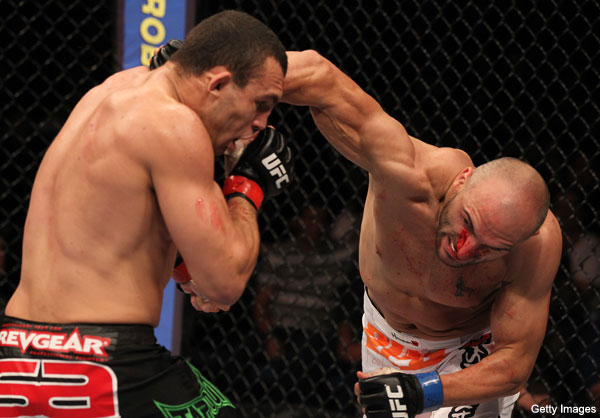 It's been nearly 13 years since the UFC last visited Brazil, the cradle of the sport. At UFC: Brazil, held October 10, 1998 in Sao Paulo, Vitor Belfort TKOed Wanderlei Silva, in Belfort's first fight at 205 lbs. and Silva's UFC debut. Frank Shamrock submitted John Lober in the main event to defend the UFC middleweight belt, and Pedro Rizzo and Pat Miletich both walked away with wins.
It's been nearly 13 years since the UFC last visited Brazil, the cradle of the sport. At UFC: Brazil, held October 10, 1998 in Sao Paulo, Vitor Belfort TKOed Wanderlei Silva, in Belfort's first fight at 205 lbs. and Silva's UFC debut. Frank Shamrock submitted John Lober in the main event to defend the UFC middleweight belt, and Pedro Rizzo and Pat Miletich both walked away with wins.
Since then, the UFC has changed just a bit. The UFC was purchased by the Fertitta brothers and Dana White, a reality show widened its reach, and the sponsors upgraded from Mickey's Malt Liquor to Budweiser. Through it all, Brazil's crucial role as the birthplace of great fighters has not changed. From Royce Gracie to Anderson Silva, many of the UFC's best call Brazil home.
This Saturday at UFC 134, the UFC finally returns. What should American MMA fans know about the sport in Brazil these days? Fernando Zanchetta, the MMA blogger for Yahoo! Sports Brazil, answered Cagewriter's questions.
Cagewriter: What is the biggest sport in Brazil?
Fernando Zanchetta: Soccer continues as the biggest sport in the country, and this will not change anytime soon. The sport is an integral part of Brazilian culture with a huge advantage over all others. Second, currently, I'd say it's volleyball, especially after the results in the Olympic Games. The country has many sports other sports it goes crazy about, too, as happened with tennis and F1, but depends only on a few stars.
MMA in Brazil still suffers a lot of prejudice. But I can say that the amount of good fighters has increased gradually, and that it has potential to follow closely the other two (soccer and volleyball).
CW: Who is Brazil's most popular fighter?
FZ: Vitor Belfort (pictured) is still the most popular of the mainstream public. He's fighting since he was 19, married a supermodel (Joana Prado) and participated in a very successful reality show at the beginning of the decade.
Last year, Anderson Silva won many fans, signed important contracts with major brands and learned how to deal better with the press. The knockout against Belfort had a great impact to the world of combat sports in the country. This will increase absurdly after UFC 134, which will be the first broadcast on open television channel in Brazil.
CW: Is MMA big in certain cities, or all over the country?
FZ: The headquarters is still Rio de Janeiro. That's where most folks want to go to evolve technically. Curitiba no longer has the same force like it did at the beginning of the decade, but follows behind Rio. Sao Paulo is the largest city, but still has only a few fighters with international fame (like Demian Maia and Luiz Cane).
The north of Brazil also brings good surprises and becomes well known as a center of hard fighting at Bel�m do Par� and Natal,�land of brothers Patrick and Patricky Freire.
CW: Are fighters still learning from luta livre or just jiu-jitsu?
FZ: Luta livre haven't developed as much as jiu-jitsu, which was the major export product of its kind in the 1990s. Today is just a sport restricted to Rio and some gyms outside Brazil. Jiu-jitsu evolution continues around the world.
CW: Are there any young stars that MMA fans should watch for?
FZ: Erick Silva, Freire brothers, Marcelo Magr�o, John Lineker, and Francisco Massaranduba are among the best to watch.
CW: What else should American MMA fans know about MMA in Brazil?
FZ: Brazil is the birthplace of the sport and it will never change. But there are still remnants of the time when the Vale Tudo was marginalized by the media and society. Now people seem to understand that MMA is a professional sport. There are more specialized media and people are more interested in fights, fighters and all stuff related to it. The new generation of fighters are beginning to take their first -- and good -- steps too.
Obrigado to Fernando for his time. Read Casca Grossa, the Brazilian Yahoo! Sports MMA blog.
Freestyle BMX Mountain Biking - Downhill inline skating Mountain Biking - Freeride Downhill Skateboarding


 The UFC wanted to send a message and it appears it worked. That's a great thing for fight fans concerning the dismissal of Strikeforce heavyweight champ Alistair Overeem.
The UFC wanted to send a message and it appears it worked. That's a great thing for fight fans concerning the dismissal of Strikeforce heavyweight champ Alistair Overeem.


 In what may have been the biggest international showcase for the
In what may have been the biggest international showcase for the 

 Jon Olav Einemo Discusses Five-Year Hiatus From MMA Video by UFC 131
Jon Olav Einemo Discusses Five-Year Hiatus From MMA Video by UFC 131

 In his first fight since losing the
In his first fight since losing the 
 This was the day Dana White dreamed about from the beginning. The UFC president's brainchild has finally reached a big deal with network television.
This was the day Dana White dreamed about from the beginning. The UFC president's brainchild has finally reached a big deal with network television.